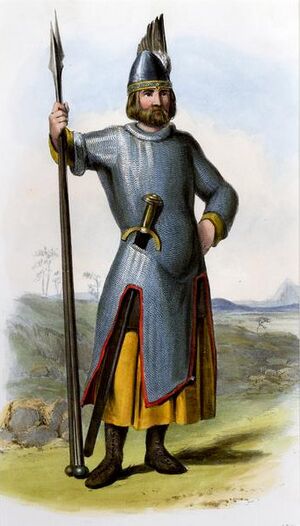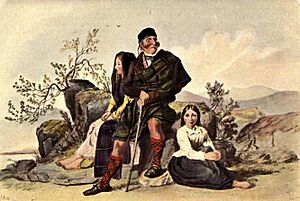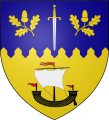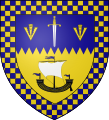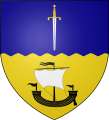Clan Macfie facts for kids
Quick facts for kids Clan Macfie |
|||
|---|---|---|---|
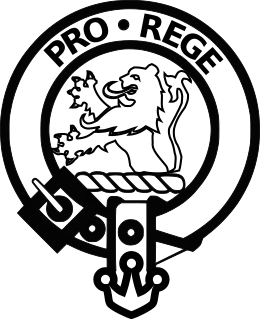
Crest: A demi lion rampant Proper
|
|||
| Motto | Pro rege (For the King) | ||
| Profile | |||
| Region | Highlands | ||
| District | Colonsay | ||
| Plant badge | Scots fir, oak or crowberry | ||
| Clan Macfie has no chief, and is an armigerous clan | |||
| Historic seat | Dùn Eibhinn | ||
| Last Chief | Malcolm Macfie of Colonsay | ||
| Died | 1623 | ||
| Commander | Ian McPhee of Halifax. | ||
|
|||
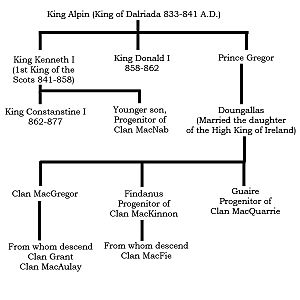
Clan Macfie is a historic Highlands Scottish Clan. It is also known as Clan MacPhee.
Since 1981, the clan has been officially recognized by the Court of the Lord Lyon. This court is Scotland's official authority for heraldry, which deals with coats of arms and family symbols.
Clan Macfie is called an armigerous clan. This means the clan is recognized, but it doesn't currently have a chief (leader) who is officially approved by the Lord Lyon King of Arms. The Lord Lyon is the main judge of the Court of the Lord Lyon.
The name Macfie comes from the old Gaelic words Mac Dhuibhshíthe. This means "son of Duibhshíth". This Gaelic family name has been changed into many different English forms. Many of these forms are now considered part of the Clan Macfie family.
The clan has a long history with the islands of Colonsay and Oronsay in the Inner Hebrides of Scotland. Today, you can find many old monuments to clan leaders and churchmen on these islands.
A historian named W. F. Skene, who lived in the 1800s, said Clan Macfie was one of the seven clans of Siol Alpin. According to Skene, these clans could all trace their family lines back to Alpin. Alpin was the father of Cináed mac Ailpín, who was an early King of Scots.
We don't know much about the clan's very early history. However, we do know that the clan served under the powerful Lords of the Isles. These Lords were descendants of Somerled. They ruled the Hebrides from the 1300s to the late 1500s.
After the Lordship of the Isles lost its power in the late 1400s, the clan still stayed loyal to powerful MacDonald families. In the early 1600s, the last chief of Clan Macfie was killed. The island of Colonsay was then taken over by a MacDonald family.
Without their own chief to lead them on their home lands, the clan became known as a "broken clan." This meant they were a clan without a recognized leader. From then on, many Macfies followed the MacDonalds of Islay. However, some members of the clan moved to lands controlled by Clan Cameron.
In the early 1800s, a man named Ewen Macphee became a famous outlaw. He was respected and feared by local people, but disliked by the authorities. Today, Clan Macfie is still active. There are nine clan societies around the world for members to connect.
Contents
History of Clan Macfie
The historian W. F. Skene believed that Clan Macfie members were the original people living on Colonsay. He also wrote that the clan was one of the seven clans of Siol Alpin. He said their family tree, found in a 1450 manuscript, showed their connection to the Macgregors and Mackinnons.
These seven clans of Siol Alpin, according to Skene, could trace their family line back to Alpin. Alpin was the father of the first traditional King of Scots, Cináed mac Ailpín. Even with this information, Skene admitted that little was known about the very early history of Clan Macfie.
Later, another historian, W. D. H. Sellar, wrote about an old Gaelic story. This story said that Dubside, an ancestor of Clan Macfie, helped raise Aonghas Mór. Aonghas Mór was an early Lord of Islay and is sometimes called the first MacDonald.
In 1703, Martin Martin wrote in his book A Description of the Western Isles of Scotland. He mentioned that near the church of St. Columba on Oronsay, there were tombstones for MacDuffie (a former chief) and his family members. The main stone had carvings of a birlinn (a type of boat), a two-handed claymore (sword), and an inscription. This inscription said, "Here lies Malcolumbus MacDuffie of Colonsay."
The Macfies' burial place was a small chapel on the south side of the church on Oronsay. Another stone belongs to Sir Donald MacDuffie. He was the abbot (head) of Oronsay when Donald Munro, a high church official, visited the Western Isles in 1549.
An old document from the 1600s talks about the crowning of the Lords of the Isles. It also mentions the Council of the Isles. This document says that "MacDuffie, or MacPhie of Colonsay, kept the records of the Isles."
In 1463, Macfie of Colonsay was part of the Council of the Isles. He was listed as Donald Macduffie. He witnessed an important document signed by John of Islay, Earl of Ross, the last Lord of the Isles. This document was dated April 12 at the Earl's castle of Dingwall.
After the Lordship of the Isles lost its power, the Macfies continued to follow the MacDonalds of Islay. In 1531, the clan chief, "Morphe Makphe de Colwisnay," and many other West Highland chiefs were accused of treason. They were called to Parliament because they supported the rebellious Alexander MacDonald. This Macfie chief passed away in 1539. His impressive tombstone can still be seen today.
In 1549, Donald Munro, a church leader, described the island of Jura. He wrote that it was partly controlled by Maclean of Duart, Maclaine of Lochbuie, and Macfie of Colonsay. When describing Colonsay, Monro wrote that it was once held by Macdonald of Kintyre. But at that time, it was ruled by a "gentle capitane, callit M’Duffyhe." Gentle meant 'well-born', and captain was an old way of saying 'chief'.
By 1587, fighting between West Highland clans had become very bad. So, the Scottish Parliament created something called the General Band. This was an effort to stop the conflicts. Landowners across the Scottish highlands, borders, and islands had to sign it. They had to promise to be responsible for the people living on their lands.
The chiefs who signed had to provide guarantees of their wealth and lands. This was to ensure their followers would act peacefully. In this document, the leader of Colonsay, "M'Fee of Collowsay" (Murdoch Macfie of Colonsay), is listed. He was one of the landlords in the Scottish Highlands and islands where broken men (lawless people) lived.
Despite the government's efforts for peace, around this time, Lachlan Mor MacLean of Duart attacked the MacDonald islands of Islay and Gigha. He caused the deaths of 500–600 men. Maclean of Duart then surrounded Angus MacDonald of Dunivaig and the Glens at his Castle Dunivaig. The attack ended only when Macdonald of Dunivaig and the Glens agreed to give up half of his lands on Islay to the Macleans.
However, even after this agreement, Macdonald of Dunivaig and the Glens then attacked the Maclean islands of Mull, Tiree, Coll, and Luing. Angus Macdonald of Dunivaig and the Glens was helped by Donald Gorm Mor Macdonald of Sleat. Many West Highland clans also helped, such as the Macdonalds of Clanranald, MacIains of Ardnamurchan, Macleods of Lewis, MacNeills of Gigha, MacAlisters of Loup, and also the Macfies of Colonsay.
Supporting Maclean of Duart were the Macleods of Harris and Dunvegan, MacNeils of Barra, Mackinnons of Strathrodle, and the Macquarries of Ulva.
In 1609, "Donald Mcfie in Collonsaye" was present at a meeting of island chiefs and gentlemen. They met with the Bishop of the Isles at Iona. During this meeting, nine rules called the Statutes of Icolmkill were created. These rules were meant to bring the Western Isles under the control of the Scottish Parliament.
The Clan Loses Its Chief
In 1615, Malcolm Macfie of Colonsay supported Sir James Macdonald of Islay. Sir James was the Chief of "Clan Donald South". Macdonald had escaped from Edinburgh Castle. Macfie was one of the main leaders in Macdonald's uprising against the government. The government had promised the island of Islay to the Campbells.
The combined forces of Macfie and Donald Gigach MacIan, a leader from the nearby island of Jura, provided 64 men to the Macdonald rebellion. When Sir James Macdonald's force of 400 men landed at Kinloch (Campbelton) in Kintyre, they included "special men" from Islay. These included Macfie of Colonsay, Donald Gigach of Jura, Allaster MacRanald of Keppoch, and men from the North Isles.
The Earl of Argyll later managed to get Colla Ciotach MacDonald to surrender. Colla Ciotach was another chief of Clan Donald South. Colla Ciotach then captured Malcolm Macfie of Colonsay, along with eighteen others. He handed them over to the Earl of Argyll. Malcolm Macfie and another rebel leader were promised their lives. They served on the government's side against the rebels while with the Earl of Argyll. The Earl presented the captured men to the Privy Council in late 1615.
For several years, both Colla Ciotach and the Macfie chief lived on Colonsay. Colla Ciotach stayed at Kiloran, and Macfie stayed at Dùn Eibhinn. During this time, the two leaders had many disagreements. Many hiding places on the island are named after Macfie, like leab' fhalaich Mhic a Phì ("MacPhee's Hiding Place"). This suggests Macfie was chased from one spot to another for a while.
Finally, in 1623, Malcolm Macfie was chased from Colonsay. He was pursued to Eilean nan Ròn, a small island southwest of Oronsay. There, on the southwestern part of Eilean nan Ròn, called an t Eilean Iarach, he was found and captured by the MacDonalds.
A popular story says that the Macfie chief was found when a gull gave away his hiding place among the seaweed. As the gull flew over Macfie's spot, Colla Ciotach's men noticed it. They then saw the clan chief on a rock ledge by the sea. After being caught, the chief was tied to a stone and quickly killed.
Colla Ciotach and some of his followers were later accused in the Council Records in 1623 of killing the Macfie chief. Because their chief died, the Macfies finally lost control of Colonsay. The island then went to the MacDonalds, as Colla Ciotach took it for himself. He held it peacefully for many years.
The island later became part of the earldom of Argyll. It was then sold in 1701 to McNeill of Crear. Without its own chief, Clan Macfie became a "broken clan." Most members then followed the MacDonalds of Islay. Macfies and Macphees made up only a small part of Colonsay's population.
After the clan's collapse, some members settled in Lochaber. They followed Cameron of Lochiel, the chief of Clan Cameron. A Macfie (a Macphee of Clan Cameron) was one of the two pipers at Glenfinnan. This was on August 19, 1745, when Charles Edward Stuart (Bonnie Prince Charlie) raised his flag. He claimed both the Scottish and English thrones for his father. The next year, Macfies were among the Camerons who fought on the right side of the Jacobite Army at the Battle of Culloden.
Ewen Macphee the Outlaw
A well-known person in Inverness-shire in the 1800s was Ewan Macphee. He lived as an outlaw. He was called Scotland's last outlaw. He didn't recognize any landowner, stole sheep, and raised a family on a small island.
Ewan Macphee was a young man when his landlord made him join a Highland Regiment in the British Army. Macphee was said to be a good soldier. But he soon left the Army without permission. He ran away to his home area of Glengarry. There, he hid in Feddan with his sister.
His Regiment then sent soldiers to arrest him for leaving. Macphee was about to be put in handcuffs on a steamer at Corpach. But he managed to escape and got away from his captors.
Ewan Macphee lived for two years around the shores of Loch Arkaig. Then he built a small shelter called a bothy on a small island in Loch Quoich. This island has since been named after him: Eilen Mhic Phee, which means "MacPhee's island" in Gaelic.
Macphee then married a fourteen-year-old girl who lived across the hill in Glen Dulochan. As time passed, Macphee was both feared and looked up to by the poor people of the glen. They saw him as someone with special insight. Macphee believed he had supernatural powers. He made charms, and people brought their sick cattle to him to be cured.
As the years went by, nearby shepherds decided to stop Macphee from stealing their sheep. The sheriff sent two officers to confront Macphee. As the officers rowed to his island, Macphee's wife shot at them, and the officers ran away. A week later, an armed group was sent. Ewan Macphee was finally arrested and taken to prison, where he eventually died.
Clan Macfie Today
In 1864, the first Macfies to have coats of arms officially registered were Robert Macfie of Langhouse and Airds, and Robert Andrew Macfie of Dreghorn. They were very successful businessmen in the sugar industry. The heraldic crest found in the clan's crest badge actually comes from the coat of arms of Robert Andrew Macfie of Dreghorn.
In 1968, Earle Douglas MacPhee of Vancouver, British Columbia, Canada started a movement. He wanted Clan Macfie to be officially registered with the Lord Lyon King of Arms. On May 10, 1977, the Macfie Standing Stone on Balaruminmore on Colonsay was dedicated. It serves as a memorial to the last chief of the clan, who was killed near it in 1623.
In May 1981, Clan Macfie was formally recognized by the Lord Lyon King of Arms. Later, in November of that year, Earle MacPhee was appointed as the Commander of Clan Macfie by the Lord Lyon King of Arms. After Earle MacPhee passed away in 1982, Alexander (Sandy) Carpendale McPhie of Australia was appointed Commander of Clan Macfie on September 7, 1989.
In March 2008, the Lord Lyon allowed Clan Macfie to hold a special meeting called an ad hoc derbhfine. This meeting was to choose a new leader because McPhie had decided to step down. Iain Morris McFie was chosen to ask the Lord Lyon for approval. He was later appointed as Commander of Clan Macfie.
-
Arms of the Macfie Clan Commander Iain Morris McFie of Coulintyre.
Today, there are nine clan societies connected to Clan Macfie. These groups are located around the world in Australia, Canada, New Zealand, Scotland, Sweden, and the United States of America.
Clan Symbols and Meanings
What Does the Name Macfie Mean?
The name Macfie (and its different spellings) comes from the Gaelic Mac Dhuibhshíthe. This means "son of Duibhshíth." The Gaelic personal name Duibhshíth is made of two parts: dubh ("black") and síth ("peace").
An early person with this name, Dub Sidhe (Dubshidhe), is mentioned in the Annals of Ulster. He was listed as a teacher in the monastic community at Iona in the year 1164. The name Macfie (and its different spellings) is written as Mac a' Phì in modern Scottish Gaelic.
An old collection of Gaelic poems, Carmina Gadelica, mentions a family on North Uist. This family was known as Dubh-sith, which means "black fairy" in Gaelic. This was because of a belief that the family had connections with fairies. This family was the North Uist MacCuishes. For a time, they often used Dubhsith as a given name.
There were never many MacCuishes on the Uist islands. After a while, Dubhsith stopped being used as a given name there. However, it continued in Cape Breton, Nova Scotia, Canada. There, it changed into forms like Dushie, Duffus, and even David. These MacCuishes (from North Uist and Skye) are considered septs (related families) of Clan Donald.
Clan Badges and Motto
Scottish crest badges are used by clan members to show they belong to their clan and chief. Like clan tartans, crest badges became popular during the Victorian era because of a love for romantic ideas about the past.
Crest badges are special symbols. They usually have the heraldic crest (a part of the chief's coat of arms) of the clan chief. This crest is surrounded by a buckle that has the chief's heraldic motto.
However, Clan Macfie does not have a chief right now. So, its crest badge comes from the coat of arms of Macfie of Dreghorn. He was one of the first Macfies to register a coat of arms in Scotland. The crest badge of Clan Macfie shows a demi lion rampant, proper. This means half a lion standing on its hind legs, shown in its natural colors. The motto around the crest is: pro rege. This is Latin and means "for the king."
Even though crest badges are common today, the original badges worn by clansmen were plant badges. These were plants worn on a bonnet (a type of hat) or attached to a pole or spear. Several plant badges are linked to Clan Macfie. The clan shares these with other related clans.
Plant badges for Clan Macfie include:
- Scots pine (Scottish Gaelic: giuthas). This is also linked to all seven clans of Siol Alpin.
- Oak (Scottish Gaelic: darag). This is also linked to Clan Cameron.
- Crowberry (Scottish Gaelic: dearca fithich). This is also linked to Clan Maclean and Clan Cameron.
Clan Macfie Tartan
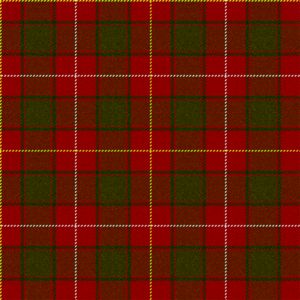
The clan's official "Clan Macfie Tartan" was registered in Scotland on August 29, 1991. It's possible the tartan might be older, perhaps from the mid-1800s when the first Macfie coats of arms were registered. However, it was first officially recorded in 1906 in a book called The Tartans of the Clans and Septs of Scotland.
The tartan looks very similar to the MacIver tartan. The main difference is that the Macfie tartan uses green where the MacIver tartan uses black. It has also been said that the colors (red, green, and yellow) and the overall look of the Macfie tartan are similar to the Cameron tartan. This might hint at the connection between some Macfies and Clan Cameron after their own clan lost its chief. The Clan Cameron Association considers the surnames MacPhee, MacFie, and MacVee as septs (members or followers) of Clan Cameron.
Related Clans and Names
Today, there are many different spellings of the clan name Macfie. All of them mean "son of Duibhshíth." People with these surnames are considered members of the clan.
Clan Macfie also has historical connections with other clans, like Clan Cameron. As mentioned, some Clan Macfie members moved to lands controlled by Clan Cameron in the 1600s. Clan Cameron considers certain spellings of Macfie as their septs.
There might also be a link between Clan Macfie and the MacNichols of Glenorchy. These MacNichols are considered a sept of Clan Campbell. We don't know for sure where the MacNichols of Glenorchy and Glenshira came from. Niall Campbell, 10th Duke of Argyll believed they were originally MacNaughtons of Dunderave.
However, local stories say they were originally MacPhees. They were said to be descendants of Nicol MacPhee, who left the Cameron-controlled Lochaber area in the 1500s. According to Somerled MacMillan, in 1971, there were many MacNichols in Lochaber. They were thought to be descendants of Clan Macfie members. However, they were said to have owned land in the Lochaber area even before 1493.
See also
- Colonsay
- Oronsay, Inner Hebrides
- Macfie
- McPhee


